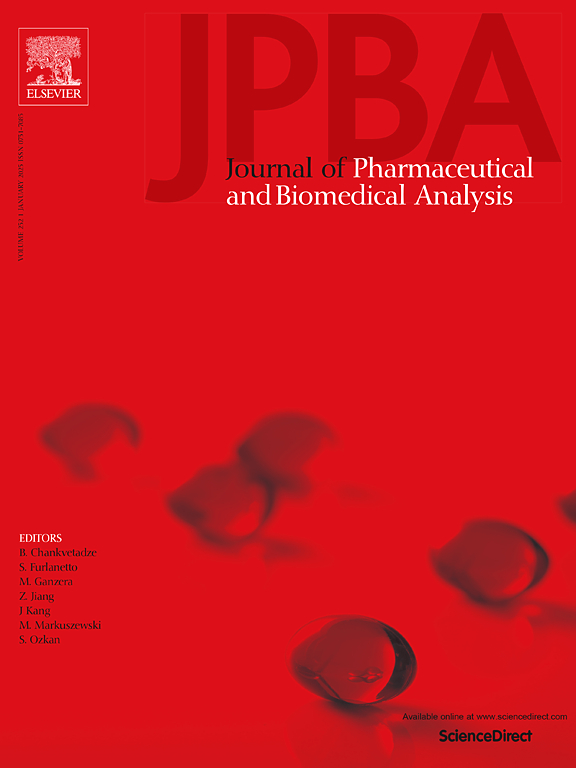Evaluating the quality consistency of Nuangong Qiwei Pills based on integrated HPLC, DSC and electrochemistry fingerprints
IF 3.1
3区 医学
Q2 CHEMISTRY, ANALYTICAL
Journal of pharmaceutical and biomedical analysis
Pub Date : 2025-04-29
DOI:10.1016/j.jpba.2025.116939
引用次数: 0
Abstract
Nuangong Qiwei Pill (NQP) is a classic Mongolian formula consisting of seven herbs, which is widely used in the treatment of gynecological diseases. To provide an integrated and comprehensive quality assessment method for NQP, multidimensional fingerprint was creatively applied to NQP. Firstly, the contents of three compounds-eugenol, agarotetrol and dehydrodiisoeugenol in 18 batches of NQPs were quantitatively analyzed. Then, the multidimensional fingerprints were established, which included the establishment of three-wavelength fusion HPLC fingerprints and their reliability, the obtaining of electrochemical fingerprints by B-Z oscillation and the analysis of nine parameters, and the obtaining of differential scanning calorimetry (DSC) quantum fingerprints by fixed-point merger method. Subsequently, systematically quantitative fingerprint method (SQFM) was employed to evaluate similarities, Finally, the qualitative and quantitative results of the fingerprint were synthesized using the coefficient of variation weighting method (CVWM), and the samples were classified into 1–5 levels, which satisfied the evaluation criteria (Sm ≥ 0.70, 70 % ≤ Pm ≤ 130 %). Overall, this study provides valuable information for ensuring the quality of NQPs and will promote the application of fingerprint technology in the Mongolian medicine filed.
基于HPLC、DSC和电化学指纹图谱综合评价暖宫七味丸的质量一致性
暖宫七味丸(NQP)是由七种草药组成的经典蒙方,广泛用于妇科疾病的治疗。为提供一种综合、全面的NQP质量评价方法,创造性地将多维指纹图谱应用于NQP。首先,定量分析了18批NQPs中丁香酚、琼脂素醇和脱氢二异丁香酚的含量。然后,建立多维指纹图谱,包括三波长融合HPLC指纹图谱的建立及其可靠性、B-Z振荡电化学指纹图谱及9个参数分析、差示扫描量热(DSC)量子指纹图谱的定点合并。随后,采用系统定量指纹法(SQFM)对相似度进行评价,最后采用变异系数加权法(CVWM)对指纹的定性和定量结果进行综合,并将样本分为1-5个等级,满足评价标准(Sm≥0.70,70 %≤Pm≤130 %)。综上所述,本研究为保证NQPs的质量提供了有价值的信息,并将促进指纹技术在蒙药领域的应用。
本文章由计算机程序翻译,如有差异,请以英文原文为准。
求助全文
约1分钟内获得全文
求助全文
来源期刊
CiteScore
6.70
自引率
5.90%
发文量
588
审稿时长
37 days
期刊介绍:
This journal is an international medium directed towards the needs of academic, clinical, government and industrial analysis by publishing original research reports and critical reviews on pharmaceutical and biomedical analysis. It covers the interdisciplinary aspects of analysis in the pharmaceutical, biomedical and clinical sciences, including developments in analytical methodology, instrumentation, computation and interpretation. Submissions on novel applications focusing on drug purity and stability studies, pharmacokinetics, therapeutic monitoring, metabolic profiling; drug-related aspects of analytical biochemistry and forensic toxicology; quality assurance in the pharmaceutical industry are also welcome.
Studies from areas of well established and poorly selective methods, such as UV-VIS spectrophotometry (including derivative and multi-wavelength measurements), basic electroanalytical (potentiometric, polarographic and voltammetric) methods, fluorimetry, flow-injection analysis, etc. are accepted for publication in exceptional cases only, if a unique and substantial advantage over presently known systems is demonstrated. The same applies to the assay of simple drug formulations by any kind of methods and the determination of drugs in biological samples based merely on spiked samples. Drug purity/stability studies should contain information on the structure elucidation of the impurities/degradants.

 求助内容:
求助内容: 应助结果提醒方式:
应助结果提醒方式:


